Frequency Modulation Spectroscopy
Frequency modulation spectroscopy is a nondestructive technology for determining the water activity of pharmaceutical samples. This article discusses the various pharmaceutical applications of frequency modulation spectroscopy, offers comparisons with various traditional water activity measurement techniques, and presents an assessment of various instrument performance elements.
The control of moisture in pharmaceutical products is often necessary to prevent deleterious chemical and physical changes to a product. Moisture-driven changes in solid oral dosage forms can have severe adverse effects on pharmaceutical quality. Hence, several measurement approaches for product-moisture content currently are in routine use in the industry. Among the most common means to ascertain moisture levels in solid oral dosage forms are destructive loss-on-drying (LOD) or Karl Fischer (KF) titration techniques. An attractive augmentative approach for examining product moisture would be to directly determine the chemical potential of water in the sample by means of water activity (Aw), which is an arguably more fundamental indicator of the available water for the promotion of chemical, physical, or biochemical change (1–4). The chemical potential of a component in a mixture—such as water—is a fundamental measure of the "escaping tendency" or the availability of the component in the mixture, rather than the total moisture (which may include water that is bound or otherwise unavailable).
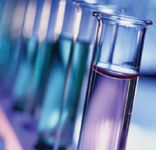
Photodisc
At typical storage temperatures and humidities for pharmaceutical solids (5–40 °C and <85% relative humidity), water behaves like an ideal gas, and the activity of water in a solid can be related to the headspace relative humidity by the following (5, 6):
Aw ~ (PW ÷ PWS ) = (relative humidity ÷ 100)
in which PW is the partial pressure of water in the headspace, and PWS is the saturated vapor pressure of water at the temperature of interest.
Thus, the relative humidity in the package headspace over a pharmaceutical solid at equilibrium can be directly related to the water activity and is an indication of the amount of water present with potential to cause undesirable changes in the pharmaceutical product.
Currently, two different types of water activity instruments are commercially available: one based on a chilled-mirror dew-point technology to measure humidity and the other based on a polymeric thin-film capacitance sensor that is responsive to headspace moisture. In both of these techniques, the sample of interest is equilibrated in a sealed chamber until equilibrium between the solid and headspace moisture is reached. The chilled-mirror instrument consists of an optical reflectance sensor that detects the exact point at which condensation first appears at the mirror–headspace gas interface. This point is determined by directing a beam of infrared light onto the mirror surface and reflecting the beam of light to a photodetector, which detects reflectance changes upon initiation of condensation. A thermoelectric (Peltier) cooler helps to control the mirror temperature precisely, and a thermocouple attached to the mirror accurately measures the dew-point temperature. Both the dew-point and measured sample-surface temperatures are then used to determine the water activity.
A less common approach involves capacitance measurements to obtain water activity results. A sensor made from a thin-film hygroscopic polymer relates the film capacitance to the headspace moisture content. Because this instrument relates an electrical signal to relative humidity, the sensor must be calibrated with known salt-solution relative humidity standards. In addition, for successful measurement, the sample and sensor must be at the same temperature. Although both of these instruments can be effectively applied to headspace moisture measurements, the nondestructive nature of frequency modulation spectroscopy (FMS) seemed to make the instrument ideal for exploration for examining the headspace moisture over pharmaceutical solids. The major shortcomings of the present techniques relate to the introduction of bias to the measurement and the inability to control measurement temperature over a wide range. Adding another sophisticated tool to the available arsenal of techniques to conduct critically important water activity measurements seemed to be worthwhile from the perspective of further refining the interface between measurement science and packaging research and development (7–9).

Figure 1: Principle and schematic of frequency modulation spectroscopy. Top figure (a) shows the frequency and intensity profile of a diode laser beam. Diagrams from left to right show an unmodulated, modulated with no absorption, and modulated with absorption by the upper sideband. Bottom figure (b) is a schematic diagram of an instrument for frequency modulation spectroscopy.
Fundamentals of frequency modulation spectroscopy
Water molecules in the gas phase absorb near infrared (NIR) light in a band of rotational transitions centered at 1400 nm. Absorbance measurements at this wavelength on typical NIR spectrometers using incoherent white-light sources lack the sensitivity to provide a useful measure of headspace moisture levels because of low-frequency lamp-intensity fluctuations. The measurement signal-to-noise (S/N) ratio can be vastly improved (100–10,000X), however, by laser-light sources and frequency modulation detection techniques (10–11). When a tunable diode laser is modulated using a radio frequency oscillator, the detection bandwidth can be shifted to higher frequency where intensity fluctuations, inherent to low frequency measurements, are minimized.
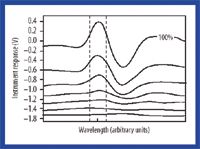
Figure 2: Frequency modulation signals from moisture absorption. The peak-to-peak amplitude of each spectrum is proportional to moisture concentration. The relative humidity is noted to the right of the 0% and 100% scan.
The frequency modulation spectroscopy measurement is conducted by frequency modulating a diode laser by superimposing a radio frequency oscillation, Ω, onto the diode injection current. The spectral output of a frequency modulated diode laser (see Figure 1) consists of a carrier frequency ωc and side band frequencies, ωc ± Ω. When the laser is scanned through the wavelength of moisture absorbance, the amount of light absorption, which is proportional to the concentration of the water molecules, is "written" into the side band frequencies by recording the difference in absorption between the two sidebands. The differential absorption information is recovered with phase-sensitive detection techniques. The demodulated absorption line shape is shown in Figure 2. The amount of light absorbed is directly proportional to the water concentration in the gas phase. The gaseous water density n is related to the peak-to-peak signal amplitude ΔI by Beer's law, which for a weakly absorbing molecule is given by:
n = (ΔI Γ π ÷ Io S x) cm-3
in which ΔI is the change in intensity of light after passing through the container (W/cm2 ), Γ is the full-width at half maximum of the absorption signal (cm-1 ), π is a constant, Io is the incident laser intensity (W/cm2 ), S is the integrated absorption cross section (cm), and x is the container diameter (cm). The measured density in a sample vial is referenced to a standard and displayed as a concentration in percent. The frequency modulated diode laser output is converted to an amplitude modulation after passing through a sample that absorbs at a particular wavelength. The amplitude modulation is detected at radio frequencies and is proportional to moisture concentration.
Materials and sample preparation
Preparation of relative humidity standard. We prepared various saturated salt solutions from USP water and ACS-certified salts (Fisher Scientific, Fair Lawn, NJ) for use as relative humidity standards. To use the samples in a headspace moisture analyzer, the saturated salt solutions were placed in an optically transparent sample vial—comprising a glass vial, a rubber stopper, and an aluminum crimp top—typically used for parenteral pharmaceutical formulations. These relative humidity standards were used for instrument calibration and for examining the performance of the headspace moisture analyzer.
Pharmaceutical sample preparation. Pharmaceutical samples included placebo tablets (comprising microcrystalline cellulose, lactose, and magnesium stearate), a gelatin-encapsulated dry product (comprising proprietary drug, sucrose, microcrystalline cellulose, hydroxypropyl cellulose, and sodium lauryl sulfate), a lyophilized product (comprising proprietary drug, gelatin, mannitol, and citric acid), desiccant (silica gel, Süd-Chemie, Munich, Germany), and a liquid-filled hard gelatin capsule (proprietary drug and lipids). To pre-equilibrate the samples at various relative humidity levels, they were stored in weigh boats (single layer) either in a variable temperature and relative humidity stability chamber (Lunaire, Williamsport, PA) or a desiccator with saturated salt solutions for 4–10 days and then sealed into the same vial–stopper–crimp top vial used to prepare the relative humidity standards.
Instrumentation
Moisture analyzer. A Lighthouse Instruments FMS 1400 headspace moisture analyzer (Lighthouse Instruments, Charlottesville, VA) was used for the frequency modulation studies. The optical head where the sample container is presented (accessible from the top) is continuously purged with nitrogen to eliminate any room air moisture from the measurement region before the experiments. Containers are inserted to the sample holder from the top of the instrument and the measured moisture concentration result is sent to the computer as well as the instrument's front-panel display. The sample holder is jacketed, thus the temperature of the sample holder and the sample can be controlled (see Figure 3).

Figure 3: Schematic of measuring cell for Lighthouse Instruments FMS 1400 device.
Typical operation of the instrument was conducted in the following sequence: The sample holder was heated or cooled to the desired measurement temperature. Next, the instrument was calibrated at the measurement temperature using a known activity solution. The water activity reading was graphically monitored in real time to ensure that the vial headspace had reached equilibrium with the sample at the measurement temperature. After the instrument was calibrated, a similar procedure was followed for the actual measurement. Each time the temperature or container was changed or the instrument was shut down, a new calibration was performed.
Instruments used for comparison in the study. A capacitive sensor (Rotronics Hygrolab III, Rotronic Instrument Corp., Huntington, NY) and a chilled-mirror dew-point analyzer (Aqualab 3TE, Decagon Devices Inc., Pullman, WA) also were evaluated for comparison. For studies conducted with the Rotronics Hygrolab III instrument, samples were placed in the measurement chamber that had been previously placed and thermally equilibrated in an circulated-air oven at the desired temperature. The sensor then was placed on top of the measurement chamber and clamped into place. Following equilibration in the sample chamber headspace, the sensor measured the relative humidity at the temperature of interest.
For the Aqualab 3TE measurements, samples were placed in the measurement chamber that was previously thermally equilibrated at the desired temperature. The samples were allowed to equilibrate, and the relative humidities over the samples were measured.
Results and discussion
Development and application of FMS for water activity measurements. The results illustrated the development and application of the FMS 1400 for water activity measurements in pharmaceutically relevant samples. Data taken from several real examples demonstrated the wide applicability of the moisture activity method for pharmaceutical samples.
We conducted studies on pharmaceutically relevant samples using a FMS sample holder at temperature settings of 25 and 40 °C (see Tables I and II). Measurements were taken on vials containing 10 tablets or capsules, a lyophilized product sample, and a single desiccant. The samples were pre-equilibrated as described previously at 10–84% RH. Tables I and II list the manner of headspace-moisture conditioning. Following this conditioning step, FMS measurements were conducted on the samples at 25 and 40 °C. Various numbers of samples (N) were prepared for repeat measurements, and the average expected %RH was determined.
In all cases, the difference between the measured RH and the expected RH was within the measurement error expected from the combined sources of sample preparation and instrument bias. The percent relative standard deviation (% RSD) for all measurements also was calculated, and as the data show, the % RSD values for replicate measurements were generally low, ranging from 1–9%. Bias, reported in %RH, also was low and varied from -1 to 1.5 in %RH units. These data demonstrate the capability of the FMS 1400 instrument to measure moisture levels in the headspace over pharmaceutical samples.
The nondestructive examination of moisture levels in a closed container allows for several applications of the FMS 1400 instrument, including the evaluation of the effect of stopper drying on headspace moisture levels for moisture-sensitive lyophilized products, moisture-vapor transmission measurements of pharmaceutical blister packaging (13), seal integrity testing (14), and the real-time determination of equilibration rates of multicomponent pharmaceutical systems (e.g., tablets and desiccant within a sealed package.)
We conducted an experiment to monitor the equilibration of a multicomponent system in real time (see Figure 4). Ten 800-mg tablets of a proprietary product (pre-equilibrated at 25 °C and 60% RH) were sealed in a vial with 2 g of desiccant. The internal RH in the vial was monitored over time using the FMS 1400 instrument, and the results of three replicate experiments were reported (see Figure 4). The multicomponent desiccant–tablet system equilibrated in less than one day, and moisture levels in the package were brought from ~60% RH to a steady-state level of 10% RH. This example illustrates the value of the nondestructive nature of the FMS 1400 analyzer measurement in that it allows for real-time data generation and may improve understanding about the interaction of moisture in various multicomponent systems.

Figure 4: Results of using the Lighthouse FMS 1400 instrument for monitoring moisture redistribution in a two-component system.
Comparison with traditional headspace moisture measurement techniques. A series of experiments was designed and conducted for comparing the FMS 1400 instrument to traditional chilled-mirror and capacitance-sensor techniques. Three areas were identified as most important for this comparison:
- the measurement of moisture activity in pre-equilibrated tablets to establish a baseline performance of methods for the prevailing sample type in a pharmaceutical setting;
- moisture retention within the instrument as measured as the bias introduced when a dry sample is preceded by a wet sample;
- sample measurement chamber leak rate as determined by measurement of change in moisture activity per hour of a wet pre-equilibrated desiccant sample.
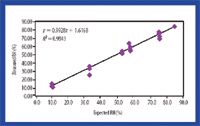
Figure 5a: Technique accuracy and linearity at 25 °C. Plot shows observed relative humidity versus expected relative humidity at a 25 °C conditioning temperature.
One of the fundamental differences between the FMS approach and the other two traditional approaches under examination in the study is that the FMS system uses individual sample vials for each sample that are sealed tightly. The other two approaches use a single sample chamber for all samples.

Figure 5b: Technique accuracy and linearity at 40 °C. Plot shows observed relative humidity versus expected relative humidity at a 40 °C conditioning temperature.
Comparison of pharmaceutical sample headspace-moisture measurements. Placebo tablets were pre-equilibrated in stability chambers at two RH levels and three temperatures, for a total of six sample treatment conditions: 25 °C and 20% RH; 25°C and 85% RH; 30°C and 35% RH; 30°C and 65% RH; 40°C and 20% RH; and 40°C and 75% RH. Two replicate measurements were performed on 10 tablets using all three headspace-moisture measurement approaches. Headspace-moisture measurements were acquired at 25, 30, and 40 °C, with tablets pre-equilibrated at the same respective temperatures. Although the FMS 1400 and chilled-mirror techniques both have in situ temperature control over the sample, the capacitive-sensor technique does not and thus the whole apparatus was housed in an oven for temperature control. The capacitive-sensor technique has two measurement settings that render it possible to perform measurements in a relatively "quick" predictive mode or a "standard" mode. Both modes were evaluated in the study (see Table III). A comparison of the biases obtained shows that traditional headspace-moisture approaches and the FMS 1400 instrument all measure headspace moisture with the same degree of accuracy.
Measurement bias resulting from instrument moisture retention. The study evaluated the bias introduced when a dry sample is introduced following measurement on a relatively wet sample. Although we expected the bias for the FMS instrument to be nonexistent because an individual sealed sample vial is used for each sample, bias could be a significant issue for the traditional approaches in which all samples must pass through a single sample measurement chamber.

Figure 6a: Plot shows percent relative standard deviation versus mean relative humidity for samples at 25 °C.
In this experiment, placebo tablets were pre-equilibrated at two humidity levels (at 25 °C and 20% RH and at 25 °C and 85% RH) for the generation of "dry" and "wet" samples for examination. Measurements first were performed on the dry sample, followed by measurement of the more wet sample, and followed again by a measurement on a fresh dry sample. Ten tablets were used for each measurement, and three replicate measurements were conducted.

Figure 6b: Plot shows percent relative standard deviation versus mean relative humidity for samples at 40 °C.
The capacitive-sensor technique measurements were conducted in the "quick" mode. Table IV shows the average of the three replicate measurements for each instrument type. On the basis of the average readings obtained following measurement on the final dry sample, the chilled-mirror technique may have a significant moisture retention, and the capacitive-sensor technique may have a moderate moisture retention (likely within the measurement error). Very low bias was observed when the FMS 1400 instrument was used, which is entirely consistent with sealed sample vials being used for the measurements. Thus, the FMS 1400 instrument demonstrated that the potential for bias introduction via moisture retention is not a problem.
Sampling vial and measurement chamber leak rate. The seal integrity of the sampling vial or measurement chamber for each technique also was evaluated. In this experiment, a 1-g desiccant canister was pre-equilibrated at 40 °C and 75% RH, and headspace moisture over the desiccant canister was monitored over a 4–8-h period at 40 °C. The change in headspace moisture levels over the time course of the measurement then were translated into an effective leak rate on the basis of the desiccant's quantity and moisture-carrying capacity. The moisture leak rates obtained for the various instruments show that the FMS 1400 instrument (<0.05 mg/h) was superior to the other traditional headspace moisture techniques (Rotronics: 0.5 mg/h; Aqualab: 6 mg/h) in terms of the potential for erroneous data generation resulting from moisture egress or ingress during measurement. The FMS 1400 instrument enables long-term measurements to be made, whereas with the other traditional techniques, it will be difficult to obtain reliable data over long time scales without introducing significant error.

Table I: Frequency modulation spectroscopy measurements at 25 °C.
Summary comparison of the various techniques. Table V summarizes key attributes of the three headspace-moisture measurement techniques. Comparison points include analysis time, instrument expense, and critical performance variables. As with any instrument comparison, the optimum technique depends on the intended application and the authors' comments should not be taken as an endorsement for any of the instruments.
All three techniques offer comparable analysis times (except in the Rotronic Hygrolab "quick" mode), although they vary greatly in cost (the FMS 1400 instrument is nearly 10 times more expensive than the capacitive-sensor technique and the chilled-mirror technique). In terms of availability, the FMS 1400 instrument is a rather new approach with the greatest research potential of the three, but availability for the instrument may be somewhat limited.

Table II: Frequency modulation spectroscopy measurements at 40 °C.
The FMS 1400 allows the water activity over lyophilized cake samples to be measured directly in a nondestructive manner. As discussed previously, the principal advantage of the FMS 1400 system is the lack of bias introduction that is associated with a sample-vial measuring system, which provides an advantage over using a single measurement chamber for all samples. As the table shows, the FMS 1400 instrument also can be used at a wider range of temperatures than the traditional capacitive-sensor and chilled-mirror techniques. Finally, the FMS 1400 sample vial is not susceptible to the leaking observed with the other two approaches.
Evaluation of the FMS 1400 instrument performance. Because frequency modulation spectroscopy is a relatively new technique, various operational parameters were evaluated to ensure that the instrument could perform as required for routine investigations and was not limited in use to only research studies. Thus, the suitability of the instrument was evaluated in terms of method specificity, accuracy–linearity, and measurement precision and range.

Table III: Comparison of three techniques for measuring headspace moisture.
Method specificity. The specificity of the FMS 1400 instrument for moisture measurements was demonstrated by measuring the headspace moisture activity of various saturated salt solutions with known equilibrium moisture activities in the presence of expected container–closure matrix components such as pure N2, pure O2, or room air at various pressures (a low of ~200 Torr versus atmospheric at 760 Torr) under a constant preconditioned temperature of 25 °C. A plot of measured RH (%) versus expected RH (%) was generated for each sample type and preconditioned temperature combination, and the slope, y-intercept and R2 values were calculated for the various salt solutions. Table VI summarizes the results and indicates that container type (i.e., amber versus clear), container size, internal pressure, and preconditioned temperature do not interfere specifically with the measurement of headspace moisture. The observed slopes (0.9–1.1), y intercepts (<5%), and R2 values (>0.98) are acceptable for the method's intended use. Therefore, we concluded that the method is insensitive to headspace gas composition and has sufficient specificity for headspace moisture.

Table IV: Comparison of moisture retention.
Accuracy and linearity. The accuracy of the FMS 1400 instrument was evaluated by comparing the mean of the measured relative humidity of freshly made saturated salt solutions with known relative humidity equilibrium values against their expected relative humidity values. Actual and theoretical values were compared at the conditioned temperatures of 25 and 40 °C (see Tables VII and VIII). The salt solution with the greatest relative deviation from the expected value at either conditioned temperature is LiCl (~16–19% difference between the expected and actual values). The accuracy obtained is considered sufficient, however, for the method's intended purpose. Linearity, expressed by R2 in Figures 5a and 5b, was >0.98 and also acceptable.
Measurement precision and range. To evaluate measurement precision, 10 consecutive headspace moisture measurements of a 50-mL clear glass vial containing 16 capsules of a gelatin encapsulated dry product were taken at 40 °C. Measurement precision, expressed by the percent relative standard deviation (% RSD) of the 10 consecutive readings, was 1.1%.

Table V: Summary of key attributes of the various headspace-moisture techniques examined in the study.
Measurement precision also was evaluated by repetitive measurements of several saturated salt solutions at 25 and 40 °C. An individual vial containing a specified saturated salt solution was prepared for each measurement (see Tables VII and VIII). As Figures 6a and 6b show, % RSD values increased as the % RH value decreased.
The ability of the FMS 1400 headspace-moisture analyzer to accurately measure relative humidity values close to 0% RH and 100% RH also was evaluated (see Table VI and Figure 6b). Five 50-mL clear vials containing USP water (with an expected relative humidity of 100%) and equilibrated at 40 °C were measured. The results (mean = 98.8%, RSD = 0.4%) suggested that the Lighthouse instrument can measuring up to 100% RH with a high degree of accuracy. At the low end, five 50-mL clear vials containing dried desiccants (with an expected relative humidity of 0%) and equilibrated at 40 °C were measured. The results (mean = 0.8%, RSD = 37.5%) suggested acceptable performance at the low end of the expected relative humidity range as well, although with less precision.
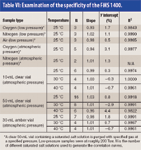
Table VI: Examination of the specificity of the FMS 1400.
Conclusion
This article introduced a novel nondestructive technique that is based on frequency modulation spectroscopy for the measurement of moisture activity in optically transparent packages. The technique appears to be a promising tool with reasonable method specificity, measurement precision, method precision, accuracy, linearity, range, and excellent analyst-to-analyst and time stability. The ability to make moisture activity measurements nondestructively for samples in a sealed glass container also enables new applications and offers significant advantages over traditional techniques.
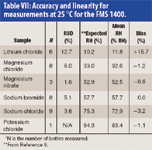
Table VII: Accuracy and linearity for measurements at 25 °C for the FMS 1400.
The sealed system avoids all sample-handling issues during the measurement because the samples are not exposed to the environment. Furthermore, there is no interference from preceding measurements or concerns for leakage (because the sealed stopper-vial system provides an excellent barrier). Some applications enabled by this technique not offered by traditional techniques include measurement of moisture activity in optically transparent packages (e.g., lyophilized products) without breach of package, measurements of samples sealed in an inert gas atmosphere, and monitoring of moisture exchange between samples in real time. The high cost of the instrument will, however, restrict widespread application of this technique.

Table VIII: Accuracy and linearity for measurements at 40 °C for the FMS 1400.
Acknowledgments
The authors thank Jim Veale and Bobby Anderson of Lighthouse Instruments, Inc., as well as the vendors of the other two instruments whose cooperation has greatly facilitated the work described in this report. The authors also thank Joshua Stull, Ngocyen Le, Elijah Tan, John Shust, Christopher Gilman, Brad Holstine, Brandon McWilliams, Jimmy George, Sean Hutchinson, and William Lewis for their help in the collection and compilation of these data.
Note
The information described in this report does not constitute endorsement of any particular instrument type or supplier by Merck & Co., Inc.
Rajiv Mahajan,* is a research fellow rajiv_mahajan@merck.comAllen C. Templeton is research fellow, Robert A. Reed is a senior director, and Rey T. Chern is a senior research fellow, all at Pharmaceutical Research & Development, Merck Research Laboratories, Merck & Co., Inc., West Point, PA 19486.
*To whom all correspondence should be addressed.
Submitted: Dec. 16, 2004. Accepted: Feb. 9, 2005.
References
1. R.R. Friedel, "The Application of Water Measurement to Microbiological Attributes Testing of Raw Materials Used in the Manufacture of Nonsterile Pharmaceutical Products," Pharm. Forum 25 (5), 8974–8981 (1999).
2. R.R. Friedel, "The Application of Water Measurement to Microbiological Attributes Testing of Nonsterile Over the Counter Drug Products," Pharm. Forum 24 (2), 6087–6090 (1998).
3. S.H. Lee and T.P. Labuza, "Destruction of Ascorbic Acid as a Function of Water Activity," J. Food Sci. 40 , 370–373 (1975).
4. M. Loncin, J.J. Bimbenet, and J. Lenges, "Influence of the Activity of Water on the Spoilage of Foodstuffs," J. Food Technol. 3, 131–142 (1968).
5. B.G. Kyle, "Principles of Phase Equilibrium" in Chemical and Process Thermodynamics (Prentice Hall, Upper Saddle River, NJ, 1984).
6. M.J. Kontny and G. Zografi, "Sorption of Water in Solids" in Physical Characterization of Pharmaceutical Solids, H.G. Brittain, Ed. (Marcel Dekker, New York, NY, 1995).
7. H. Xu et al.,"Rapid, Simultaneous Determination of Headspace Oxygen and Moisture in Pharmaceutical Packages using muGC," J. Pharm. Biomed. Anal. 38 (2), 225–231 (2005).
8. A.C. Templeton et al., "Rapid Headspace Oxygen Analysis for Pharmaceutical Packaging Applications," Pharm. Technol.26 (7), 41–61 (2002).
9. A.C. Templeton et al., "Determination of the Moisture Content of Bromobutyl Rubber Stoppers as a Function of Processing: Implications Toward the Stability of Lyophilized Products," PDA J. Pharm. Sci. Technol. 57 (2), 75–87 (2003).
10. J.N. Demas, B.A. DeGraff, and P.B. Coleman, "Oxygen Sensors based on Luminescence Quenching," Anal. Chem. 71 (23), 793–801 (1999).
11. G.C. Bjorklund, "Frequency-Modulated Spectroscopy: A New Method for Measuring Weak Absorptions and Dispersions," Optic Letters 5, 15–18 (1980).
12. Lange's Handbook of Chemistry, J.A. Dean, Ed. (McGraw-Hill, New York, NY, 14th ed., 1992).
13. W.R. Anderson, W.M. Griffith, and J.R. Veale, "Tunable Diode Laser Spectroscopy: A Rapid and Nondestructive Method for Assessing Moisture Permeation through Blister Packages," poster presented at the American Association of Pharmaceutical Scientists Annual Conference, Toronto, Canada, Nov. 10–14 2002.
14. T.P. Lin et al., "Application of Frequency Modulated Spectroscopy in Vacuum-Seal Integrity Testing of Lyophilized Biological Products," PDA J. Pharma. Sci. Technol. 58 (2), 106–115 (2004).

Drug Solutions Podcast: Applying Appropriate Analytics to Drug Development
March 26th 2024In this episode of the Drug Solutions Podcast, Jan Bekker, Vice President of Business Development, Commercial and Technical Operations at BioCina, discusses the latest analytical tools and their applications in the drug development market.
Full Tolerance Coverage Method for Assessing Uniformity of Dosage Units with Large Sample Sizes
March 10th 2025The ‘full tolerance coverage method’ is introduced as a coverage estimation approach for assessing the uniformity of dosage units from large sample sizes, ensuring that no dosage unit exceeds the specification range.
Inspiration Over Desperation: Accurant Biotech CEO Talks Leadership, Innovation, and Motivation
March 4th 2025Xiao-Yan Cai, PhD, shares insights into her leadership style, the importance of motivation in the workplace, and how she balances repetition with innovation, discussing how hobbies and resilience uniquely shape her professional approach, emphasizing the value of perseverance and preparation in both science and life.